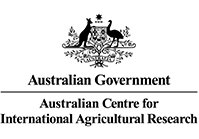
Pacific Pests, Pathogens & Weeds - Mini Fact Sheet Edition
Yam anthracnose & dieback (016)

Summary
- Worldwide distribution. There are many strains of the fungus attacking crops and weeds. An important disease.
- A wet weather fungus mainly on greater yam. Spots on young leaves expand rapidly causing them to fall early. Shoots die back, and old leaves turn black. New shoots grow from the sett, but if they become infected, these die back, too. Often, there are no tubers, or just many small ones.
- Spread occurs when spores are moved in wind-driven rain and, perhaps, long distance in planting setts.
- Cultural control: plant early ahead of rainy season; check setts for rot; interplant with maize; do not weed when plants are wet; collect and burn trash after harvest; resistant varieties; 3-year crop rotation.
- Chemical control: copper, chlorothalonil, or mancozeb.
Common Name
Yam dieback, yam anthracnose, lightening disease of
yam
Scientific Name
Glomerella cingulata (it also has the name of Colletotrichum gloeosporioides). Glomerella is the sexual state of the fungus.
AUTHORS Helen Tsatsia & Grahame Jackson
Produced with support from the Australian Centre for International Agricultural Research under project PC/2010/090: Strengthening integrated crop management research in the Pacific Islands in support of sustainable intensification of high-value crop production, implemented by the University of Queensland and the Secretariat of the Pacific Community.
This mini fact sheet is a part of the app Pacific Pests, Pathogens & Weeds
The mobile application is available from the Google Play Store and Apple iTunes.




Copyright © 2020. All rights reserved.
 Pacific Pests, Pathogens & Weeds - Mini Fact Sheet Edition
Pacific Pests, Pathogens & Weeds - Mini Fact Sheet Edition